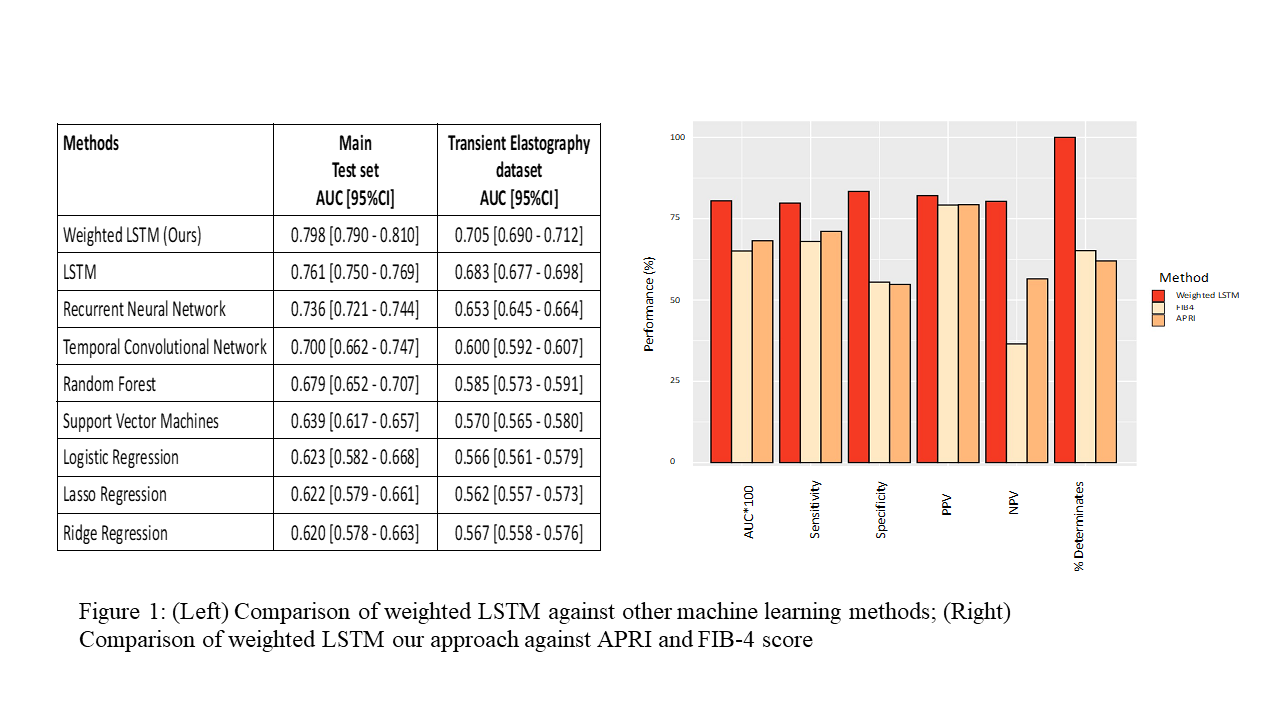Real-Time Application of Deep Learning in Diagnosis of Graft Fibrosis After Liver Transplantation Using Longitudinal Data
1Ajmera Transplant Program, University Health Network, Toronto, ON, Canada, 2Department of Biostatistics, Princess Margaret Cancer Centre, University Health Network, Toronto, ON, Canada, 3Biostatistics Division, Dalla Lana School of Public Health, University of Toronto, Toronto, ON, Canada
Meeting: 2022 American Transplant Congress
Abstract number: 321
Keywords: Graft failure, Graft function, Liver grafts, Liver transplantation
Topic: Clinical Science » Liver » 62 - Liver: Large Data and Artificial Intelligence
Session Information
Session Name: MELD Allocation and Large Data
Session Type: Rapid Fire Oral Abstract
Date: Monday, June 6, 2022
Session Time: 5:30pm-7:00pm
 Presentation Time: 6:30pm-6:40pm
Presentation Time: 6:30pm-6:40pm
Location: Hynes Room 313
*Purpose: Graft fibrosis develops insidiously in liver transplant recipients and is associated with worse survival. Early detection of fibrosis is essential to avoid further progression of the disease and the need for re-transplantation. Serum fibrosis biomarkers are routinely used for fibrosis screening but with limited accuracy. Deep learning algorithms (DLAs) can find non-linear relationship and temporal trends among longitudinal parameters. In this study, we evaluated the accuracy of DLAs in detecting significant fibrosis (F2 and above) using longitudinal follow up data.
*Methods: We developed an advanced neural network, Long Short-Term Memory Networks (LSTMs) using longitudinal data from 1,744 recipients with at least one liver biopsy after transplant between Jan 1992-June 2020 (544 recipients with stage 2 fibrosis and above; 1200 recipients with F0-F1 fibrosis). 167091 repeated measures of 25 longitudinal clinical and laboratory parameters from date of transplant to biopsy were used for model training. A validation dataset (N=149; 47 cases, 102 controls) with associated Transient Elastography (TE) readings within 1 year from liver biopsy was used to show generalizability of our model.
*Results: The best performing model, Weighted LSTM provided an AUC of 0.798 (95% CI: [0.790 – 0.810]) for detection of significant fibrosis using the test set and AUC of 0.705 (95% CI: [0.690 – 0.712]) on the validation dataset (Figure 1). Weighted LSTM outperformed AST-to-platelet ratio index (APRI) and FIB-4 scores (AUC: 0.798 Weighted LSTM, 0.682 APRI and 0.650 FIB-4; Figure 1). Also, weighted LSTM performed slightly better than TE (AUC: 0.705 (95% CI: 0.687-0.724) versus 0.667 (95% CI: 0.647-0.683)). Recipient and donor age, creatinine, ALT, AST, bilirubin, and immunosuppressive medication serum levels were found among the top ranked features predictive of fibrosis severity.
*Conclusions: In this study, we showed that DLAs trained on longitudinal clinical and laboratory data performed better than APRI, FIB-4, and TE in detecting recipients with significant fibrosis. This model can be used for regular screening of liver transplant recipients for graft fibrosis, flagging high-risk patients among them for more invasive diagnostic methods, and help clinicians with personalized management based on most important predictive features.
To cite this abstract in AMA style:
Azhie A, Sharma D, Sheth P, Xu W, Bhat M. Real-Time Application of Deep Learning in Diagnosis of Graft Fibrosis After Liver Transplantation Using Longitudinal Data [abstract]. Am J Transplant. 2022; 22 (suppl 3). https://atcmeetingabstracts.com/abstract/real-time-application-of-deep-learning-in-diagnosis-of-graft-fibrosis-after-liver-transplantation-using-longitudinal-data/. Accessed December 13, 2025.« Back to 2022 American Transplant Congress

